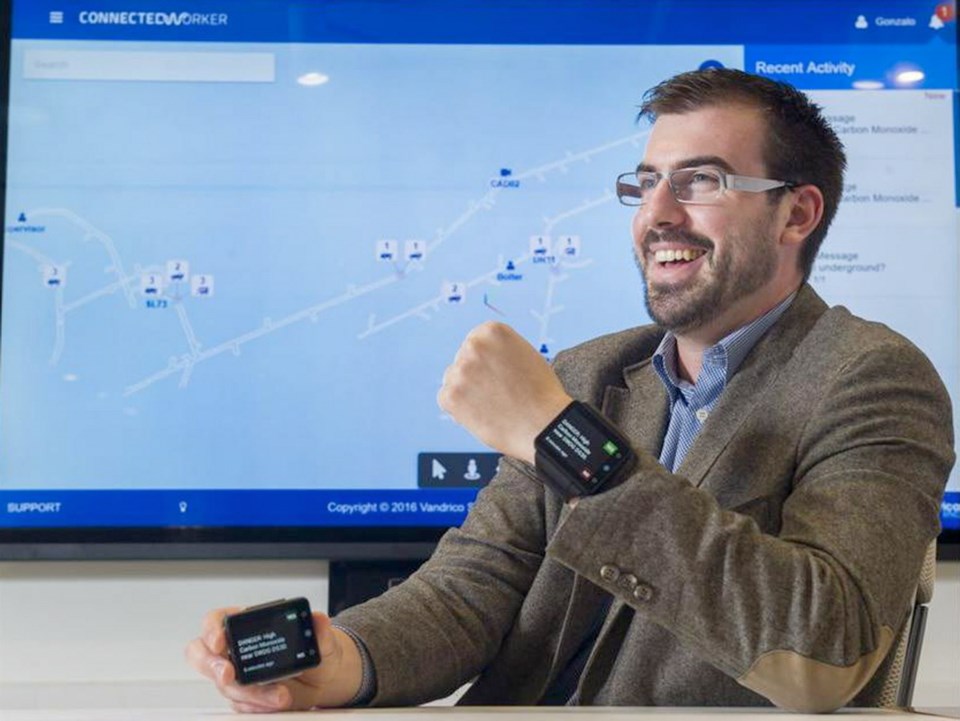VANCOUVER — From the sleek confines of a technology lab in downtown Vancouver, Gonzalo Tudela pitches his company’s vision for the future of the connected workplace that can be extended to the field operations of a utility company, a ski resort or a heavy equipment distributor.
He brings up the graphic layout of an underground mine on a large, touch-screen “dashboard” that ties together real-time information from sensors on machines, cameras in operational areas and heavy-duty smartwatches on employees.
“I’m calling this situational awareness, or context-aware communication,” said Tudela, CEO of the Vancouver tech startup Vandrico Inc.
The system is made possible by the convergence of powerful computing, machine-to-machine communications, the so-called Internet of Things, and sophisticated software that rapidly analyzes data as it comes in to present a useful, real-time picture.
With the system Vandrico is developing, Tudela said, a supervisor can schedule tasks to avoid delays, warn workers when they are about to enter areas where remote sensors show dangerous conditions or spot deviations from a work plan that need to be fixed.
“Better situational awareness leads to better operations,” Tudela said.
It is an extension of technology already used in B.C. to help the forestry sector cope with the mountain pine beetle infestation, the mining industry use remotely operated systems and manufacturers deploy automated machines.
It is referred to as “Industry 4.0,” said University of B.C. professor Yusuf Altintas, an expert in manufacturing automation in the department of mechanical engineering, because it represents the fourth generation of technological advancement since the Industrial Revolution.
“Every [machine] must communicate with one another. Machines must be very intelligent, self-adjusting, self-optimizing,” said Altintas. “This is the Internet of Things.”
Altintas chairs a seven-university Natural Science and Engineering Research Council project aimed at developing such intelligent machines.
The first automated machines weren’t computer-controlled because computing at the time was so expensive, Altintas said.
It has been the massive increase in computing power, in ever-shrinking packages, coupled with development of sophisticated sensors, which can read, analyze and act on thousands of bits of information a second, that has unleashed machines. Now, they can work far beyond the capabilities of people.
“In the beginning, it was a dumb machine,” Altintas said. “Now, it can make decisions by its own.”
It was advances in that kind of sensor technology that helped B.C.’s forest industry adapt to the disaster of the mountain pine beetle infestation, allowing mills to turn beetle-damaged logs into usable products, said Darrell Wong, research manager for solid wood products at the industry research group FP Innovations.
Sensors, in the form of devices called optimizers, have been a part of sawmill operations for decades, Wong said.
Sensors were first used to measure the dimension of logs to figure out how to maximize the amount of lumber cut from each one. In decades past, a mill might have had one optimizer measuring logs at the start of the process. But today, a mill might have five or 10, all connected by computer and working in parallel.
Wong said mills have added visual sensors, X-ray sensors and microwave sensors to scan for the grade of timber or detect defects such as cracks or rot. That information is transmitted to machines further down the production line to adjust the cutting decisions for each stick of lumber.
“These decisions are made in the scale of milliseconds,” Wong said.
The advances, he added, have allowed mills to nearly double their speed.
“I don’t know that a lot of people understand that saw milling is one of the most sophisticated manufacturing processes you’ll find anywhere in the world,” Wong said.
In mining, there is also a drive to introduce some of those concepts of manufacturing into the brute-force business of digging minerals out of rock, partly to reduce costs, partly to find ways of reducing the environmental impact of mining, but largely to improve safety.
Vancouver-headquartered Goldcorp Inc., for instance, built its new Eleonore mine in Quebec with wireless communication throughout the underground facility, which allows some of the machines to be operated remotely from the surface.
“We want to be able to mine at lower cost, we’re always competing on that,” said Brent Bergeron, Goldcorp’s executive vice-president of corporate affairs and sustainability. “[But] doing it in a way where our workers feel much safer and want to continue working for mining companies because they feel like we’re investing in safer technologies.”



